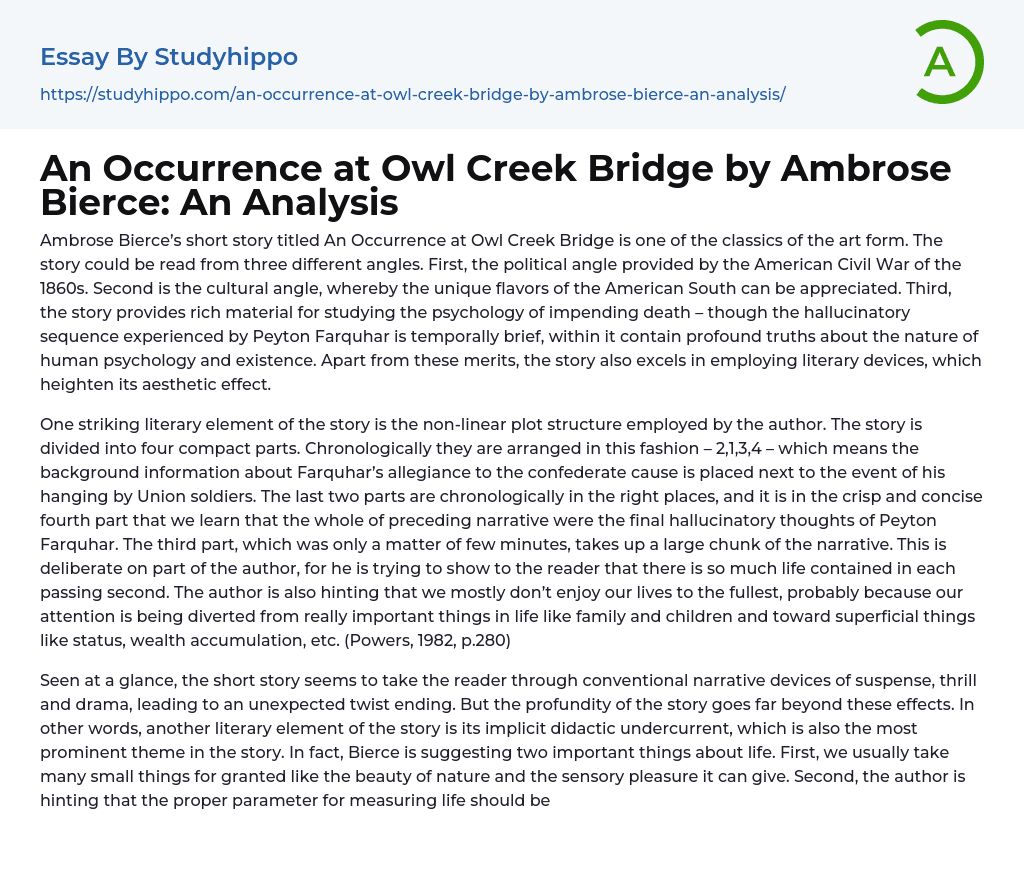

An Occurrence at Owl Creek Bridge by Ambrose Bierce: An Analysis Essay Example
Ambrose Bierce’s short story, An Occurrence at Owl Creek Bridge, is a classic work that can be interpreted from three perspectives.
Firstly, it offers a political angle, exploring the American Civil War of the 1860s.
Secondly, it provides insight into the cultural nuances of the American South.
Thirdly, it delves into the psychology of impending death, as Peyton Farquhar's hallucinatory experience reveals profound truths about human psychology and existence.
In addition to these merits, the story also showcases skillful use of literary devices that enhance its aesthetic impact.
The author employs a non-linear plot structure in the story, dividing it into four parts: 2,1,3,4 chronologically. This arrangement places Farquhar's allegiance to the confederate cause alongside his hanging by Union soldiers. The last two parts are correctly ordered chronologically. In the concise fourth part, we discover that the preceding narrative
...represents Farquhar's final hallucinatory thoughts. Although only lasting a few minutes, the third part occupies a significant portion of the narrative. Through this technique, the author aims to illustrate that every passing second holds a substantial amount of life and suggests that our failure to fully appreciate our lives often stems from excessive focus on superficial concerns like status and wealth rather than essential aspects such as family and children (Powers, 1982, p.280).
Upon initial examination, the short story appears to adhere to familiar storytelling techniques involving suspense, thrill, and drama, which ultimately lead to an unexpected twist ending. However, the story possesses a deeper layer that extends beyond these effects. In essence, it incorporates an implied educational undertone that serves as its prevailing theme. Bierce conveys two significant insights about life through his narrative. Firstly, he highlights our tendency to overloo
various small details such as the innate beauty of nature and the sensory pleasure it provides. Secondly, the author suggests that the value of life should be evaluated based on its quality and intensity rather than solely focusing on quantity. Moreover, Bierce underscores how time is subjective and adaptable in relation to human sensory and cognitive experiences. Rather than being strictly measured, the experience of living—particularly with regards to events occurring at a rapid pace—has the potential to distort time in unimaginable ways (Stoicheff, 1993,p.351).
The above points emphasize the unique literary style and inclusion of psychological insights found in Ambrose Bierce's story. Furthermore, its universal appeal distinguishes it from others as it surpasses cultural, national, and setting boundaries in terms of significance and applicability. Even if "An Occurrence at Owl Creek Bridge" were to occur in a different time or place, its popularity would persist because it revolves around a man's love for his family and how it influences his thoughts before dying - something universally relatable. Since psychology aims to understand common anxieties and fears of the human mind, this story serves as an excellent case study for students. It is important to note that despite being fictional, this story belongs to the genre of realism rather than fantasy or science-fiction.
Works Cited:
Primary Source:
The URL for Ambrose Bierce's "An Occurrence at Owl Creek Bridge" is http://fiction.eserver.org/occurrence_at_owl_creek.html. It was accessed on December 17th, 2010.
Secondary sources:
Gale, Robert L. An Ambrose Bierce Companion. Westport, CT: Greenwood Press, 2001.
Stoicheff, Peter. "Something Uncanny": The Dream Structure in Ambrose Bierce's "An Occurrence at Owl Creek Bridge." Studies in Short Fiction, vol. 30, no. 3, 1993, pp. 349+.
The citation for
the article "Freud and Farquhar: An Occurrence at Owl Creek Bridge?" by James G. Powers is as follows:
Author: James G. Powers
Title of Article: Freud and Farquhar: An Occurrence at Owl Creek Bridge?
Journal: Studies in Short Fiction
Volume: 19
Issue: Summer 1982
Pages: 278–281
Ambrose Bierce's renowned short story, An Occurrence at Owl Creek Bridge, holds a special place in the field of literature. It offers multiple lenses through which it can be understood, be it social, cultural, psychological, or political. The political aspect stems from its setting during the American Civil War in the 1860s. Additionally, it provides an opportunity to appreciate the distinctive flavors of the American South, highlighting the cultural dimension. Furthermore, the story delves into the psychology surrounding impending death, providing rich material for exploration. Alongside these merits, Bierce's exceptional use of literary devices enhances its aesthetic impact. The narrative unfolds familiar themes found in Bierce's other works; dark imagery, ambiguous timelines, concise descriptions, war as a backdrop, and encounters with the magical and surreal. Thus, An Occurrence at Owl Creek Bridge not only offers diverse analytical perspectives but also showcases the author's unique artistic touch.
- Age Of Enlightenment essays
- Ethos essays
- Time essays
- Acceptance essays
- Meaning Of Life essays
- Reality essays
- Natural Law essays
- Political Philosophy essays
- Utilitarianism essays
- Existence essays
- Free Will essays
- Good And Evil essays
- Confucianism essays
- Relativism essays
- Conscience essays
- Environmentalism essays
- Empiricism essays
- Epistemology essays
- Ethics essays
- Existentialism essays
- Human Nature essays
- Individualism essays
- Metaphysics essays
- Philosophy Of Life essays
- Transcendentalism essays
- Truth essays
- Destiny essays
- Determinism essays
- Fate essays
- Functionalism essays
- Philosophers essays
- Pragmatism essays
- Future essays
- Child Observation essays
- Critical Reflection essays
- Teaching Philosophy essays
- Personal Philosophy essays
- Action Speak Louder Than Words essays
- Can Money Buy Happiness essays
- Values of Life essays
- Ethical dilemma essays
- Normative Ethics essays
- Virtue Ethics essays
- Belief essays
- Deontology essays
- Moral essays
- Virtue essays
- Work Ethic essays
- Henry David Thoreau essays
- Carl Jung essays



